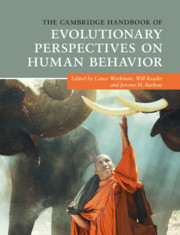Book contents
- The Cambridge Handbook of Evolutionary Perspectives on Human Behavior
- The Cambridge Handbook of Evolutionary Perspectives on Human Behavior
- Copyright page
- Dedication
- Contents
- Figures
- Tables
- Contributors
- Preface
- Acknowledgments
- Part I The Comparative Approach
- Part II Sociocultural Anthropology and Evolution
- Part III Evolution and Neuroscience
- Part IV Group Living
- Part V Evolution and Cognition
- 17 Runaway Processes in Modern Human Culture
- 18 Ontogeny of Tactical Deception
- 19 The Evolution of Language
- 20 The Adaptive Problem of Exploiting Resources
- Part VI Evolution and Development
- Part VII Sexual Selection and Human Sex Differences
- Part VIII Abnormal Behavior and Evolutionary Psychopathology
- Part IX Applying Evolutionary Principles
- Part X Evolution and the Media
- Index
- References
20 - The Adaptive Problem of Exploiting Resources
Human Foraging Behavior in Patchy Environments
from Part V - Evolution and Cognition
Published online by Cambridge University Press: 02 March 2020
- The Cambridge Handbook of Evolutionary Perspectives on Human Behavior
- The Cambridge Handbook of Evolutionary Perspectives on Human Behavior
- Copyright page
- Dedication
- Contents
- Figures
- Tables
- Contributors
- Preface
- Acknowledgments
- Part I The Comparative Approach
- Part II Sociocultural Anthropology and Evolution
- Part III Evolution and Neuroscience
- Part IV Group Living
- Part V Evolution and Cognition
- 17 Runaway Processes in Modern Human Culture
- 18 Ontogeny of Tactical Deception
- 19 The Evolution of Language
- 20 The Adaptive Problem of Exploiting Resources
- Part VI Evolution and Development
- Part VII Sexual Selection and Human Sex Differences
- Part VIII Abnormal Behavior and Evolutionary Psychopathology
- Part IX Applying Evolutionary Principles
- Part X Evolution and the Media
- Index
- References
Summary
Over evolutionary time, humans have had to solve problems regarding many important foraging activities, such as deciding where to find crucial resources, when to move on to more resource-rich locations with higher intake rates, and how well past foraging success might predict the future likelihood of return. This chapter will argue that these reoccurring foraging behaviors of our ancestral past left an eminent footprint in our evolved cognitive system – and specifically in our information processing mechanisms that deal with risk and uncertainty. This chapter on evolution, cognition, and decision-making will review empirical work from animal behavior, biological anthropology, and evolutionary psychology to show that our mind possesses various cognitive foraging adaptations that coevolved with the statistical regularities of natural resource environments.
- Type
- Chapter
- Information
- Publisher: Cambridge University PressPrint publication year: 2020



